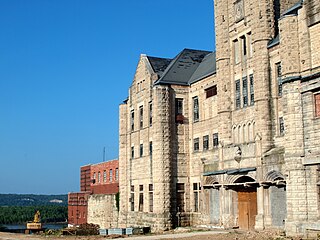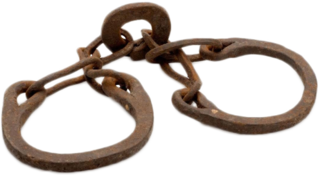External links
- Homepage of Prison Performing Arts
Prison Performing Arts is a literacy and performing arts program aimed at adults and children incarcerated in Missouri jails and prisons.
Prison Performing Arts was featured on a dedicated episode of NPR's This American Life where they followed men incarcerated in prison in Pacific, Missouri as they performed Act V of Shakespeare's Hamlet .

The Violent Crime Control and Law Enforcement Act of 1994, commonly referred to as the 1994 Crime Bill, or the Clinton Crime Bill, is an Act of Congress dealing with crime and law enforcement; it became law in 1994. It is the largest crime bill in the history of the United States and consisted of 356 pages that provided for 100,000 new police officers, $9.7 billion in funding for prisons which were designed with significant input from experienced police officers. Sponsored by U.S. Representative Jack Brooks of Texas, the bill was passed by Congress and signed into law by President Bill Clinton. Then-Senator Joe Biden of Delaware drafted the Senate version of the legislation in cooperation with the National Association of Police Organizations, also incorporating the Assault Weapons ban and the Violence Against Women Act (VAWA) with Senator Orrin Hatch.

The prison-industrial complex (PIC) is a term, coined after the "military-industrial complex" of the 1950s, used by scholars and activists to describe the many relationships between institutions of imprisonment and the various businesses that benefit from them.

Prison Fellowship is the world's largest Christian nonprofit organization for prisoners, former prisoners, and their families, and a leading advocate for justice reform.
Skinner v. State of Oklahoma, ex rel. Williamson, 316 U.S. 535 (1942), is a unanimous United States Supreme Court ruling that held that laws permitting the compulsory sterilization of criminals are unconstitutional as it violates a person's rights given under the 14th Amendment of the United States Constitution, specifically the Equal Protection Clause and the Due Process Clause. The relevant Oklahoma law applied to "habitual criminals" but excluded white-collar crimes from carrying sterilization penalties.

Incarceration in the United States is one of the primary means of punishment for crime in the United States. In 2021, over five million people were under supervision by the criminal justice system, with nearly two million people incarcerated in state or federal prisons and local jails. The United States has the largest known prison population in the world. It has 5% of the world’s population while having 20% of the world’s incarcerated persons. China, with more than four times more inhabitants, has fewer persons in prison. Prison populations grew dramatically beginning in the 1970s, but began a decline around 2009, dropping 25% by year-end 2021.

Recidivism is the act of a person repeating an undesirable behavior after they have experienced negative consequences of that behavior, or have been trained to extinguish it. Recidivism is also used to refer to the percentage of former prisoners who are rearrested for a similar offense.

A debtors' prison is a prison for people who are unable to pay debt. Until the mid-19th century, debtors' prisons were a common way to deal with unpaid debt in Western Europe. Destitute people who were unable to pay a court-ordered judgment would be incarcerated in these prisons until they had worked off their debt via labour or secured outside funds to pay the balance. The product of their labour went towards both the costs of their incarceration and their accrued debt. Increasing access and lenience throughout the history of bankruptcy law have made prison terms for unaggravated indigence obsolete over most of the world.

Prison reform is the attempt to improve conditions inside prisons, improve the effectiveness of a penal system, reduce recidivism or implement alternatives to incarceration. It also focuses on ensuring the reinstatement of those whose lives are impacted by crimes.

A super-maximum security (supermax) or administrative maximum (ADX) prison is a "control-unit" prison, or a unit within prisons, which represents the most secure level of custody in the prison systems of certain countries.

Carrie Katherine "Kate" Richards O'Hare was an American Socialist Party activist, editor, and orator best known for her controversial imprisonment during World War I.

Wally Lamb is an American author known as the writer of the novels She's Come Undone and I Know This Much Is True, both of which were selected for Oprah's Book Club. He was the director of the Writing Center at Norwich Free Academy in Norwich from 1989 to 1998 and has taught Creative Writing in the English Department at the University of Connecticut.
Reginald R. Gross is an American former professional boxer who competed from 1982 to 1988. His most notable wins were a first round knockout of future long-time IBF world Light-Heavyweight champion "Prince" Charles Williams, as well as upsets of undefeated Smokin' Bert Cooper (TKO8) and outstanding amateur and 16-0 pro Jimmy Clark (TKO9).

The United States in 2022 had the fifth highest incarceration rate in the world, at 541 people per 100,000. Between 2019 and 2020, the United States saw a significant drop in the total number of incarcerations. State and federal prison and local jail incarcerations dropped by 14% from 2.1 million in 2019 to 1.8 million in mid-2020. The incarceration total has risen since then. In 2018, the United States had the highest incarceration rate in the world.

A prison, also known as a jail, gaol, penitentiary, detention center, correction center, correctional facility, remand center, hoosegow, and slammer, is a facility where people are imprisoned under the authority of the state, generally as rehabilitation and punishment for various crimes. Prisons are most commonly used within a criminal-justice system by authorities: people charged with crimes may be imprisoned until their trial; those who have pleaded or been found guilty of crimes at trial may be sentenced to a specified period of imprisonment.

Lesbian, gay, bisexual, transgender and queer (LGBTQ) people face difficulties in prison such as increased vulnerability to sexual assault, other kinds of violence, and trouble accessing necessary medical care. While much of the available data on LGBTQ inmates comes from the United States, Amnesty International maintains records of known incidents internationally in which LGBTQ prisoners and those perceived to be lesbian, gay, bisexual or transgender have suffered torture, ill-treatment and violence See Homelessness among LGBT youth in the United States, and LGBT youth vulnerability.

The Missouri State Penitentiary was a prison in Jefferson City, Missouri, that operated from 1836 to 2004. Part of the Missouri Department of Corrections, it served as the state of Missouri's primary maximum security institution. Before it closed, it was the oldest operating penal facility west of the Mississippi River. It was replaced by the Jefferson City Correctional Center, which opened on September 15, 2004. The penitentiary is now a tourist attraction, and guided tours are offered.

The incarceration of women in the United States refers to the imprisonment of women in both prisons and jails in the United States. There are approximately 219,000 incarcerated women in the US according to a November 2018 report by the Prison Policy Initiative, and the rate of incarceration of women in the United States is at a historic and global high, with 133 women in correctional facilities per every 100,000 female citizens. The United States is home to just 4% of the world's female population, yet the US is responsible for 33% of the entire world's incarcerated female population. The steep rise in the population of incarcerated women in the US is linked to the complex history of the war on drugs and the US's prison–industrial complex, which lead to mass incarceration among many demographics, but had particularly dramatic impacts on women and especially women of color. However, women made up only 10.4% of the US prison and jail population, as of 2015.

Penal labor in the United States is the practice of using incarcerated individuals to perform various types of work, either for government-run or private industries. Inmates typically engage in tasks such as manufacturing goods, providing services, or working in maintenance roles within prisons. Prison labor is legal under the 13th Amendment to the U.S. Constitution, which prohibits slavery and involuntary servitude, except as punishment for a crime.
In the United States, prisons are obligated to provide health care to prisoners. Such health care is sometimes called correctional medicine. In women's prisons, correctional medicine includes attention to reproductive health.

Pinto or Pinta is a member of a Chicano subculture of people who are or have been incarcerated. It is an in-group moniker used to distinguish oneself from the general prison population or from "model inmates." It is a term which embraces the oppositional elements of being a Convicto. The term came from a bilingual play on the Spanish word for penitencia (penitence), since pintos and pintas are people who have spent time in penitentiaries. The term has also been traced to the Spanish word Pintao.